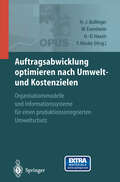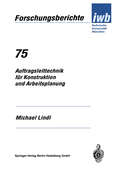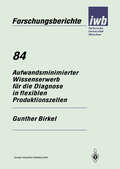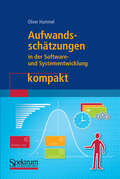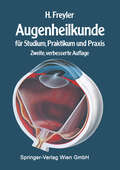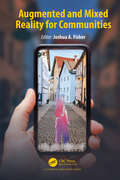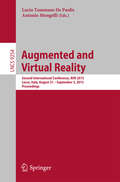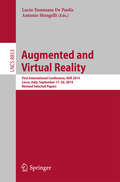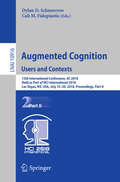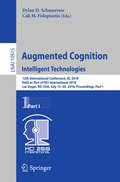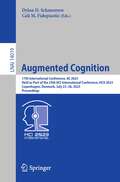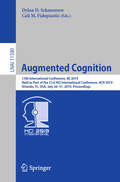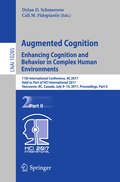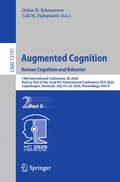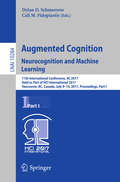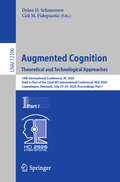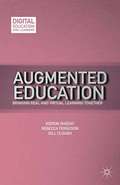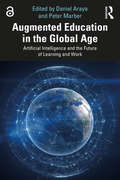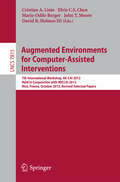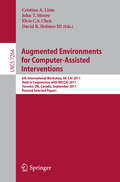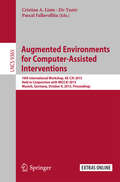- Table View
- List View
Auftragsabwicklung optimieren nach Umwelt- und Kostenzielen: OPUS — Organisationsmodelle und Informationssysteme für einen produktionsintegrierten Umweltschutz
by G. JürgensAuftragsleittechnik für Konstruktion und Arbeitsplanung (iwb Forschungsberichte #75)
by Michael LindlAufwandsminimierter Wissenserwerb für die Diagnose in flexiblen Produktionszellen (iwb Forschungsberichte #84)
by Gunther BirkelDie vorliegende Dissertation entstand während meiner Tätigkeit als wissen schaftlicher Mitarbeiter am Institut für Werkzeugmaschinen und Betriebswissen schaften (iwb) der Technischen Universität München. Den Herren Prof. Dr. -lng. J. Milberg und Prof. Dr. -Ing. G. Reinhart, den Leitern dieses Instituts, gilt mein besonderer Dank für die wohlwollende Förderung und großzügige Unterstützung meiner Arbeit. Herrn Prof. Dr. -lng. K. Bender, dem Leiter des Lehrstuhls für Informations technik im Maschinenwesen der Technischen Universität München, danke ich für die Übernahme des Korreferates und die aufmerksame Durchsicht der Arbeit. Darüber hinaus möchte ich allen Mitarbeiterinnen und Mitarbeitern des Instituts und allen Studenten, die mich bei der Erstellung meiner Arbeit unterstützt haben, recht herzlich danken. München, Oktober 1994 Gunther Birkel Inhaltsverzeichnis Inhaltsverzeichnis 1 Einleitung 1 1. 1 Ausgangssituation 1 1. 2 Zielsetzung 3 1. 3 Vorgehensweise 3 2 Wissenserwerb für die Diagnose in Produktionszellen - Stand der Technik 5 2. 1 Übersicht 5 2. 2 Flexible Produktionssysteme 5 2. 2. 1 Struktur der flexiblen Produktion 5 2. 2. 2 Informationsverarbeitung in der flexiblen Produktion 7 2. 3 Diagnose in flexiblen Produktionssystemen 9 2. 3. 1 Gegenstand der Diagnose 9 2. 3 . 2 Diagnose auf unterschiedlichen Hierarchieebenen 10 2. 4 Diagnose auf Zellenebene 13 2. 4. 1 Diagnoseverfahren 13 2. 4. 2 Wissensbasierte Diagnose 16 2. 4. 3 Bestehende wissensbasierte Diagnosesysteme 19 2. 5 Wissenserwerb für die Diagnose auf Zellenebene 22 2. 5. 1 Relevantes Wissen für die Diagnose 22 2. 5. 2 Bestehende Verfahren zum Wissenserwerb 24 2.
Aufwandsschätzungen in der Software- und Systementwicklung kompakt (IT kompakt)
by Oliver HummelEndlich ein Buch, das die zahlreichen Fallstricke bei Aufwandsschätzungen für die Entwicklung von Softwaresystemen aufzeigt und konkrete Strategien für deren Vermeidung anbietet. Es stellt die Möglichkeiten und Grenzen gängiger Schätzverfahren dar und illustriert sie mit Hilfe von Beispielen so prägnant, dass einer direkten praktischen Anwendung nichts mehr im Wege steht. Eine Sammlung der wichtigsten Tabellen und Formeln rundet dieses Buch ab und macht es sowohl für die industrielle Praxis und Weiterbildung als auch für die akademische Ausbildung zum handlichen Nachschlagewerk.
Augmented and Mixed Reality for Communities
by Joshua A. FisherUsing mixed and augmented reality in communities is an emerging media practice that is reshaping how we interact with our cities and neighbors. From the politics of city hall to crosswalks and playgrounds, mixed and augmented reality will offer a diverse range of new ways to interact with our communities. In 2016, apps for augmented reality politics began to appear in app stores. Similarly, the blockbuster success of Pokémon Go illustrated how even forgotten street corners can become a magical space for play. In 2019, a court case in Milwaukee, Wisconsin, extended first amendment rights to augmented reality. For all the good that these emerging media provide, there will and have been consequences. Augmented and Mixed Reality for Communities will help students and practitioners navigate the ethical design and development of these kinds of experiences to transform their cities. As one of the first books of its kind, each chapter in the book prepares readers to contribute to the Augmented City. By providing insight into how these emerging media work, the book seeks to democratize the augmented and mixed reality space.Authors within this volume represent some of the leading scholars and practitioners working in the augmented and mixed reality space for civic media, cultural heritage, civic games, ethical design, and social justice. Readers will find practical insights for the design and development to create their own compelling experiences. Teachers will find that the text provides in-depth, critical analyses for thought-provoking classroom discussions.
Augmented and Mixed Reality for Communities
by Joshua A. FisherUsing mixed and augmented reality in communities is an emerging media practice that is reshaping how we interact with our cities and neighbors. From the politics of city hall to crosswalks and playgrounds, mixed and augmented reality will offer a diverse range of new ways to interact with our communities. In 2016, apps for augmented reality politics began to appear in app stores. Similarly, the blockbuster success of Pokémon Go illustrated how even forgotten street corners can become a magical space for play. In 2019, a court case in Milwaukee, Wisconsin, extended first amendment rights to augmented reality. For all the good that these emerging media provide, there will and have been consequences. Augmented and Mixed Reality for Communities will help students and practitioners navigate the ethical design and development of these kinds of experiences to transform their cities. As one of the first books of its kind, each chapter in the book prepares readers to contribute to the Augmented City. By providing insight into how these emerging media work, the book seeks to democratize the augmented and mixed reality space.Authors within this volume represent some of the leading scholars and practitioners working in the augmented and mixed reality space for civic media, cultural heritage, civic games, ethical design, and social justice. Readers will find practical insights for the design and development to create their own compelling experiences. Teachers will find that the text provides in-depth, critical analyses for thought-provoking classroom discussions.
Augmented and Virtual Reality: Second International Conference, AVR 2015, Lecce, Italy, August 31 - September 3, 2015, Proceedings (Lecture Notes in Computer Science #9254)
by Lucio Tommaso De Paolis Antonio MongelliThis book constitutes the refereed proceedings of the Second International Conference on Augmented and Virtual Reality, AVR 2015, held in Lecce, Italy, in September 2015.The 32 papers and 8 short papers presented were carefully reviewed and selected from 82 submissions. The SALENTO AVR 2015 conference brings together a community of researchers from academia and industry, computer scientists, engineers, and physicians in order to share points of views, knowledge, experiences, and scientific and technical results related to state-of-the-art solutions and technologies on virtual and augmented reality applications for medicine, cultural heritage, education, industrial sectors, as well as the demonstration of advanced products and technologies.
Augmented and Virtual Reality: First International Conference, AVR 2014, Lecce, Italy, September 17-20, 2014, Revised Selected Papers (Lecture Notes in Computer Science #8853)
by Lucio Tommaso De Paolis Antonio MongelliThis book constitutes the thoroughly revised papers of the First International Conference on Augmented and Virtual Reality, AVR 2014, held in Lecce, Italy, in September 2014. The 28 papers, 2 tutorials and 3 keynotes presented were carefully reviewed and selected from 76 submissions. They include topics from virtual/augmented/mixed reality to 3D user interfaces and the technology needed to enable these environments to a wide range of applications (medical, entertainment, military, design, manufacture, maintenance, arts and cultural heritage).
Augmented Cognition: 12th International Conference, AC 2018, Held as Part of HCI International 2018, Las Vegas, NV, USA, July 15-20, 2018, Proceedings, Part II (Lecture Notes in Computer Science #10916)
by Dylan D. Schmorrow Cali M. FidopiastisThis two-volume set LNCS 10915 and 10916 constitutes the refereed proceedings of the 12h International Conference on Augmented Cognition, AC 2018, held as part of the 20th International Conference on Human-Computer Interaction, HCII 2018, in Las Vegas, NV, USA in July 2018. The 1171 papers presented at HCII 2018 conferences were carefully reviewed and selected from 4346 submissions. The papers cover the entire field of human-computer interaction, addressing major advances in knowledge and effective use of computers in a variety of applications areas. The papers in this volume are organized in the following topical sections:Cognitive modeling, perception, emotion and interaction, augmented learning and training, shared cognition, team performance and decision-making.
Augmented Cognition: 12th International Conference, AC 2018, Held as Part of HCI International 2018, Las Vegas, NV, USA, July 15-20, 2018, Proceedings, Part I (Lecture Notes in Computer Science #10915)
by Dylan D. Schmorrow Cali M. FidopiastisThis two-volume set LNCS 10915 and 10916 constitutes the refereed proceedings of the 12h International Conference on Augmented Cognition, AC 2018, held as part of the 20th International Conference on Human-Computer Interaction, HCII 2018, in Las Vegas, NV, USA in July 2018. The 1171 papers presented at HCII 2018 conferences were carefully reviewed and selected from 4346 submissions.The papers cover the entire field of human-computer interaction, addressing major advances in knowledge and effective use of computers in a variety of applications areas. The papers in this volume are organized in the following topical sections: context aware adaption strategies in augmented cognition, brain sensors and measures for operational environments, artificial intelligence and machine learning in augmented cognition, augmented cognition in virtual and mixed reality.
Augmented Cognition: 15th International Conference, AC 2021, Held as Part of the 23rd HCI International Conference, HCII 2021, Virtual Event, July 24–29, 2021, Proceedings (Lecture Notes in Computer Science #12776)
by Dylan D. Schmorrow Cali M. FidopiastisThis book constitutes the proceedings of the 15th International Conference on Augmented Cognition, AC 2021, held as part of the 23rd International Conference, HCI International 2020, held as a virtual event, in July 2021. The total of 1276 papers and 241 posters included in the 36 HCII 2021 proceedings volumes was carefully reviewed and selected from 5222 submissions.AC 2021 includes a total of 32 regular papers; they were organized in topical sections named: BCI and brain activity measurement physiological measuring and human performance; modelling human cognition; and augmented cognition in complex environments.
Augmented Cognition: 16th International Conference, AC 2022, Held as Part of the 24th HCI International Conference, HCII 2022, Virtual Event, June 26 – July 1, 2022, Proceedings (Lecture Notes in Computer Science #13310)
by Dylan D. Schmorrow Cali M. FidopiastisThis book constitutes the refereed proceedings of the 16th International Conference on Augmented Cognition, AC 2022, held as part of the 23rd International Conference, HCI International 2022, which was held virtually in June/July 2022.The total of 1271 papers and 275 posters included in the HCII 2022 proceedings was carefully reviewed and selected from 5487 submissions. The AC 2022 proceedings aims to develop adaptive systems capable of extending the information management capacity of individuals through computing technologies and offers a broad range of theoretical and applied issues related to Augmented Cognition and its applications.
Augmented Cognition: 17th International Conference, AC 2023, Held as Part of the 25th HCI International Conference, HCII 2023, Copenhagen, Denmark, July 23–28, 2023, Proceedings (Lecture Notes in Computer Science #14019)
by Dylan D. Schmorrow Cali M. FidopiastisThis book constitutes the refereed proceedings of 17th International Conference, AC 2023, held as part of the 25th International Conference, HCI International 2023, which was held virtually in Copenhagen, Denmark in July 2023. The total of 1578 papers and 396 posters included in the HCII 2023 proceedings was carefully reviewed and selected from 7472 submissions. The AC 2023 conference focuses on topics related to Brain-Computer Interfaces and neurotechnology; neuroergonomics, physiological measurements, and human performance; evolving theory and practice of AC; Augmented and Virtual Reality for AC; as well as understanding human cognition and performance in IT security.
Augmented Cognition: 13th International Conference, AC 2019, Held as Part of the 21st HCI International Conference, HCII 2019, Orlando, FL, USA, July 26–31, 2019, Proceedings (Lecture Notes in Computer Science #11580)
by Dylan D. Schmorrow Cali M. FidopiastisThis book constitutes the refereed proceedings of the 13th International Conference on Augmented Cognition, AC 2019, held as part of the 21st International Conference on Human-Computer Interaction, HCII 2019, in Orlando, FL, USA in July, 2019. The 1274 full papers and 209 posters presented at the HCII 2019 conferences were carefully reviewed and selected from 5029 submissions. The papers cover the entire field of human-computer interaction, addressing major advances in knowledge and effective use of computers in a variety of applications areas. The papers in this volume are organized in the following topical sections: cognitive modeling, perception, emotion and interaction; human cognition and behavior in complex tasks and environments; brain-computer interfaces and electroencephalography; and augmented learning.
Augmented Cognition. Enhancing Cognition and Behavior in Complex Human Environments: 11th International Conference, AC 2017, Held as Part of HCI International 2017, Vancouver, BC, Canada, July 9-14, 2017, Proceedings, Part II (Lecture Notes in Computer Science #10285)
by Dylan D. Schmorrow Cali M. FidopiastisThis volume constitutes the proceedings of the 11th International Conference on Augmented Cognition, AC 2017, held as part of the International Conference on Human-Computer Interaction, HCII 2017, which took place in Vancouver, BC, Canada, in July 2017. HCII 2017 received a total of 4340 submissions, of which 1228 papers were accepted for publication after a careful reviewing process. The papers thoroughly cover the entire field of Human-Computer Interaction, addressing major advances in knowledge and effective use of computers in a variety of application areas.The two volumes set of AC 2017 presents 81 papers which are organized in the following topical sections: electroencephalography and brain activity measurement, eye tracking in augmented cognition, physiological measuring and bio-sensing, machine learning in augmented cognition, cognitive load and performance, adaptive learning systems, brain-computer interfaces, human cognition and behavior in complex tasks and environments.
Augmented Cognition. Human Cognition and Behavior: 14th International Conference, AC 2020, Held as Part of the 22nd HCI International Conference, HCII 2020, Copenhagen, Denmark, July 19–24, 2020, Proceedings, Part II (Lecture Notes in Computer Science #12197)
by Dylan D. Schmorrow Cali M. FidopiastisThis book constitutes the refereed proceedings of 14th International Conference on Augmented Cognition, AC 2020, held as part of the 22nd International Conference on Human-Computer Interaction, HCII 2020, in July 2020. The conference was planned to be held in Copenhagen, Denmark, but had to change to a virtual conference mode due to the COVID-19 pandemic.From a total of 6326 submissions, a total of 1439 papers and 238 posters has been accepted for publication in the HCII 2020 proceedings. The 21 papers presented in this volume were organized in topical sections as follows: cognitive modeling, perception, emotion and interaction; electroencephalography and BCI; and AI and augmented cognition.
Augmented Cognition. Neurocognition and Machine Learning: 11th International Conference, AC 2017, Held as Part of HCI International 2017, Vancouver, BC, Canada, July 9-14, 2017, Proceedings, Part I (Lecture Notes in Computer Science #10284)
by Dylan D. Schmorrow Cali M. FidopiastisThis volume constitutes the proceedings of the 11th International Conference on Augmented Cognition, AC 2017, held as part of the International Conference on Human-Computer Interaction, HCII 2017, which took place in Vancouver, BC, Canada, in July 2017. HCII 2017 received a total of 4340 submissions, of which 1228 papers were accepted for publication after a careful reviewing process. The papers thoroughly cover the entire field of Human-Computer Interaction, addressing major advances in knowledge and effective use of computers in a variety of application areas.The two volumes set of AC 2017 presents 81 papers which are organized in the following topical sections: electroencephalography and brain activity measurement, eye tracking in augmented cognition, physiological measuring and bio-sensing, machine learning in augmented cognition, cognitive load and performance, adaptive learning systems, brain-computer interfaces, human cognition and behavior in complex tasks and environments.
Augmented Cognition. Theoretical and Technological Approaches: 14th International Conference, AC 2020, Held as Part of the 22nd HCI International Conference, HCII 2020, Copenhagen, Denmark, July 19–24, 2020, Proceedings, Part I (Lecture Notes in Computer Science #12196)
by Dylan D. Schmorrow Cali M. FidopiastisThis book constitutes the refereed proceedings of 14th International Conference on Augmented Cognition, AC 2020, held as part of the 22nd International Conference on Human-Computer Interaction, HCII 2020, in July 2020. The conference was planned to be held in Copenhagen, Denmark, but had to change to a virtual conference mode due to the COVID-19 pandemic.From a total of 6326 submissions, a total of 1439 papers and 238 posters has been accepted for publication in the HCII 2020 proceedings. The 21 papers presented in this volume were organized in topical sections as follows: cognitive modeling, perception, emotion and interaction; electroencephalography and BCI; and AI and augmented cognition.
Augmented Education: Bringing Real and Virtual Learning Together (Digital Education and Learning)
by K. Sheehy R. Ferguson G. CloughIncluding relevant case studies and interviews with practitioners, Augmented Education explores the nature of learning where the 'real world' is augmented by use of the virtual to create new learning possibilities, tools, and environments. and offers insights into the development of a pedagogy that is authentic, inclusive and enjoyable.
Augmented Education in the Global Age: Artificial Intelligence and the Future of Learning and Work
by Daniel Araya Peter MarberAugmented Education in the Global Age: Artificial Intelligence and the Future of Learning and Work is an edited collection that explores the social impact of Artificial Intelligence over the coming decades, specifically how this emerging technology will transform and disrupt our contemporary institutions. Chapters in this book discuss the history of technological revolutions and consider the anxieties and social challenges of lost occupations, as well as the evolution of new industries overlapping robotics, biotechnology, space exploration, and clean energy. Chapter authors unpack the nature of augmented education, from revamping curriculum and personalizing education, to redesigning workplace learning for an algorithmic era. Ultimately the book discusses policy and planning for an augmented future, arguing that work and learning are undergoing a metamorphosis around creativity and innovation amid a new global era and the race against automating technologies. Bringing together expert perspectives from around the world, this exciting, informative collection of research and analysis helps educators, policymakers and analysts navigate the future of work and learning amid rapid and accelerating technological change. The Open Access version of this book, available at http://www.taylorfrancis.com, has been made available under a Creative Commons Attribution-Non Commercial-No Derivatives (CC-BY-NC-ND) 4.0 license.
Augmented Education in the Global Age: Artificial Intelligence and the Future of Learning and Work
Augmented Education in the Global Age: Artificial Intelligence and the Future of Learning and Work is an edited collection that explores the social impact of Artificial Intelligence over the coming decades, specifically how this emerging technology will transform and disrupt our contemporary institutions. Chapters in this book discuss the history of technological revolutions and consider the anxieties and social challenges of lost occupations, as well as the evolution of new industries overlapping robotics, biotechnology, space exploration, and clean energy. Chapter authors unpack the nature of augmented education, from revamping curriculum and personalizing education, to redesigning workplace learning for an algorithmic era. Ultimately the book discusses policy and planning for an augmented future, arguing that work and learning are undergoing a metamorphosis around creativity and innovation amid a new global era and the race against automating technologies. Bringing together expert perspectives from around the world, this exciting, informative collection of research and analysis helps educators, policymakers and analysts navigate the future of work and learning amid rapid and accelerating technological change. The Open Access version of this book, available at http://www.taylorfrancis.com, has been made available under a Creative Commons Attribution-Non Commercial-No Derivatives (CC-BY-NC-ND) 4.0 license.
Augmented Environments for Computer-Assisted Interventions: 7th International Workshop, AE-CAI 2012, Held in Conjunction with MICCAI 2012, Nice, France, October 5, 2012, Revised Selected Papers (Lecture Notes in Computer Science #7815)
by Cristian A. Linte Elvis C. S. Chen Marie-Odile Berger John T. Moore David Holmes IIIThis book constitutes the refereed proceedings of the International Workshop on Augemented Environments for Computer-Assisted Interventions, held in conjunction with MICCAI 2012, in Nice, France in September 2012. The 16 revised full papers presented were carefully reviewed and selected from 22 submissions. The papers cover the topics of image registration and fusion, calibration, visualization and 3D perception, hardware and optical design, real-time implementation, as well as validation, clinical applications, and clinical evaluation.
Augmented Environments for Computer-Assisted Interventions: 6th International Workshop, AE-CAI 2011, Held in Conjunction with MICCAI 2011, Toronto, ON, Canada (Lecture Notes in Computer Science #7264)
by Cristian A. Linte John Moore Elvis Chen David Holmes IIIThis book constitutes the refereed proceedings of the International Workshop on Augemented Environments for Computer-Assited Interventions, held in conjunction with MICCAI 2011, in Toronto, Canada, in September 2011. The 13 revised full papers presented were carefully reviewed and selected from 21 submissions. The papers cover the following topics: image registration and fusion, calibration, visualisation and 3D perception, hardware and optical design, real-time implementations, validation, clinical applications and clinical evaluation.
Augmented Environments for Computer-Assisted Interventions: 10th International Workshop, AE-CAI 2015, Held in Conjunction with MICCAI 2015, Munich, Germany, October 9, 2015. Proceedings (Lecture Notes in Computer Science #9365)
by Cristian A Linte Ziv Yaniv Pascal FallavollitaThis book constitutes the refereed proceedings of the 10th International Workshop on Augmented Environments for Computer-Assisted Interventions, held in conjunction with MICCAI 2015, in Munich, Germany in October 2015. The 15 revised full papers presented were carefully reviewed and selected from 21 submissions. The objective of the AE-CAI workshop was to attract scientific contributions that offer solutions to the technical problems in the area of augmented and virtual environments for computer-assisted interventions, and to provide a venue for dissemination of papers describing both complete systems and clinical applications.
